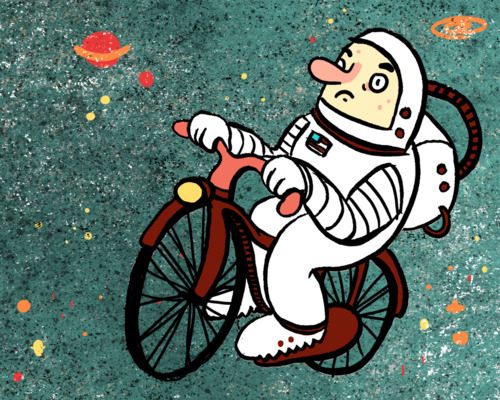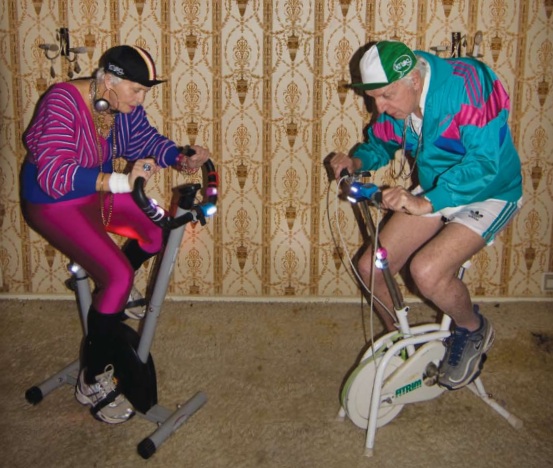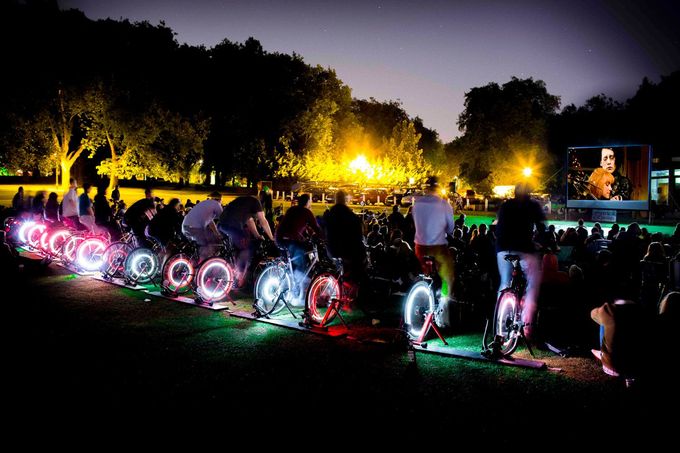
Can you cycle in space? Do cars cause most bike crashes? Could a chimp be a cyclist? How can you ride faster?
If you’ve ever stroked your chin over pressing questions like these, ponder no longer. We asked cycle science writer Max Glaskin to shed some light…
1) A novice cyclist will gain more speed by training hard than they would from upgrading to a better bike.

Over a 40km time trial a 25-year-old male weighing 70kg would gain just 1.44 mins by switching from a round steel tube frame to an aero frame.
He would gain 7.18 mins by changing from no training to training at maximum effect.
2) 70% of bike crashes don’t involve collisions with any other vehicle.
 They’re mostly related to poor road and cycle path infrastructure, rather than the silly example above though. Cornering can also cause problems for beginner cyclists.
They’re mostly related to poor road and cycle path infrastructure, rather than the silly example above though. Cornering can also cause problems for beginner cyclists.
Very recent research into how we reach for things has shown that the further away an object is the quicker we reach for it, which scientists think means our instinct when turning a tight corner would be to oversteer.
Regular cyclists quickly learn to override that instinct.
3) Regular cyclists find it hard to ride tricycles.
 Even adult-sized ones. It’s counter-intuitive for those used to riding a bike.
Even adult-sized ones. It’s counter-intuitive for those used to riding a bike.
On a corner a tricycle can’t be leaned to keep the rider’s centre of mass inside the curve, it will only corner when the handlebar is turned.
4) Tandems are faster than solo bikes.
 A pair of identical twins each outputting 160 watts energy on a tandem could travel at 22.1 mph while just one of them on a solo bike would achieve only 19.3 mph.
A pair of identical twins each outputting 160 watts energy on a tandem could travel at 22.1 mph while just one of them on a solo bike would achieve only 19.3 mph.
This is due to an aerodynamic advantage, though that’s lost at low speeds and on hills.
Rear riders or stokers as they’re known do get it easier it appears too, with a 16-22 % lower heart rate and 23-70% less lactic acid in their blood.
5) We’re not the only species that can ride a bike.
 As this old ethically dubious footage shows. Though a chimp can’t rotate its thumb to squeeze it against its fingertips so unscrewing tyre valve caps and tightening spoke nipples would be a problem.
As this old ethically dubious footage shows. Though a chimp can’t rotate its thumb to squeeze it against its fingertips so unscrewing tyre valve caps and tightening spoke nipples would be a problem.
This guy looks happy enough just cruising though… 
6) In space you could only cycle in a straight line as you need gravity to steer.

Recent experiments in the US have shown. Though you’d also need to secure your bike to the ground to enact such a scenario in space.
You couldn’t hear your bicycle bell in space either as sound doesn’t transmit in a vacuum.
7) A good bike can ride without you, as long as its speed maintains roughly 8.7 mph.
 Best try it with someone else’s good bike though and maybe don’t send it over jumps…
Best try it with someone else’s good bike though and maybe don’t send it over jumps… 
8) The first bike craze saw Regency dandies charging about on what were in effect balance bikes.

Though they had solid wooden wheels with wooden spokes and weighed a tonne, which made them quite dangerous once they got a bit of speed up as they were very difficult to stop.
Young men would challenge each other’s testosterone by throwing themselves down steep hills to see if they could survive.
9) Riding at altitude can make you cranky.
A study showed elite athletes were significantly more “angry, tired, confused, depressed and tense” on a two hour ride at altitude than at sea level.
So you definitely don’t want to get in the peloton’s way in the mountains stages of the Tour de France.
10) If a cyclist is wearing headphones but has just one earbud in they’ll react as quickly as they would if they weren’t wearing headphones.

11) Where as a car driver on a mobile phone has their reactions reduced to that of a drunk driver.
 Even if it’s hands-free. So when they’re driving with a mobile, laptop and earphones in like this guy best hope you’re not in their way.
Even if it’s hands-free. So when they’re driving with a mobile, laptop and earphones in like this guy best hope you’re not in their way.
12) Cycling is no more dangerous than walking but it’s a lot more fun.
Studies show cycling and walking have exactly the same risk per mile travelled in the UK in terms of people being killed or seriously injured.
13) And the more people that cycle the safer it is.
 Which is exactly what the folk behind Critical Mass, the monthly global protest rides, have been literally saying since they launched in San Francisco in 1992.
Which is exactly what the folk behind Critical Mass, the monthly global protest rides, have been literally saying since they launched in San Francisco in 1992.
Studies in Portland, Oregon and the Netherlands have shown death from bike traffic accidents declines when cycling commuting rises.
It’s thought more visible cyclists changes driver behaviour making them more used to driving around cyclists.
It also encourages cities to improve infrastructure and reduces the number of cars on the road so there are less cars to collide with cyclists.
14) Cycling has the lowest impact on the environment of all modes of transport.
 For every 1km pedalled across the course of its life a bicycle uses the equivalent of 200kj of the earth’s resources, the next most frugal is a peak hour bus which uses more than three times as much.
For every 1km pedalled across the course of its life a bicycle uses the equivalent of 200kj of the earth’s resources, the next most frugal is a peak hour bus which uses more than three times as much.
15) The right kind of rucksack can make you ride faster as it makes you more aerodynamic.
 It creates a smooth shape across your back when you’re cycling in an aerodynamic pose and avoids a vortex forming behind you which can hold you back.
It creates a smooth shape across your back when you’re cycling in an aerodynamic pose and avoids a vortex forming behind you which can hold you back.
They’ve been banned in races for that very reason. The wrong kind will add to your drag and a poorly fitting rucksack can even affect your breathing capacity.
16) You’d need three cyclists to power a plasma TV though almost 50 more to watch it in a room with AC.

An average cyclist can produce 100 watts of energy pedalling continuously at speeds of up to 15 mph.
In the 2004 Tour de France, when Alpe d’Huez was notoriously used as a time trial stage, a 495 watt output was recorded for Lance Armstrong.
He could have kept two devices on standby and powered a fridge.
17) If you lie to a cyclist about temperature they’ll ride harder.
 A study used menthol on cyclists’ skin to trick them into believing they were less hot than they thought they were. They rode harder as a result.
A study used menthol on cyclists’ skin to trick them into believing they were less hot than they thought they were. They rode harder as a result.
18) The fitter you get the faster your reactions.
 Scientists have shown the reaction times of fit riders are significantly faster than those of less fit riders, a physiological improvement brought about through regular exercise.
Scientists have shown the reaction times of fit riders are significantly faster than those of less fit riders, a physiological improvement brought about through regular exercise.
At 80% of pedalling effort an unfit rider’s reaction time was 134.3% times that of the fit rider.
A matter of milliseconds but potentially enough to avoid a collision. Though you’d probably still hit the dog.
19) Scientists have invented external car airbags to reduce the impact of a crash on cyclists.
 They were invented by the Dutch National Physics Lab TNO and could be used on cars within a decade.
They were invented by the Dutch National Physics Lab TNO and could be used on cars within a decade.
Car safety features have traditionally focused on protecting the driver and passengers but these airbags come out of the bonnet and seek to protect cyclists and pedestrians at the most common and dangerous point of impact.
20) Cycling can add two years to your life expectancy.
 According to studies with almost 17,000 Harvard alumni for up to 16 years and 30,000 adults in Copenhagen over 14 years.
According to studies with almost 17,000 Harvard alumni for up to 16 years and 30,000 adults in Copenhagen over 14 years.
Another study showed blue-collar workers who cycled to be as fit as their non-cycling colleagues who were 10 years younger.
21) Helmets can be a red herring in the safety debate.
 They’re designed to protect your head if you fall off not if you’re in collision with a large lump of metal travelling at 40mph.
They’re designed to protect your head if you fall off not if you’re in collision with a large lump of metal travelling at 40mph.
The real problem is the conflict between bikes and motor vehicles: segregated lanes, traffic calming measures, and making cars safer through technology can all help improve that.
Max Glaskin is the author of Cycling Science: How Rider and Machine Work Together, published by Frances Lincoln.
He tweets at CyclingScience1
He’s running a Cycling Science talk with experiments at the Edinburgh International Science Festival on Sunday 12 April, with Professor Andrea Sella.
A Cycling Science talk with experiments plus Cycling Science Rides with experiments from 24-26 April in Chester.
And Cycling Science Rides with experiments plus a Cycling Science talk with experiments with Professor Andrea Sella on Sunday 21 June in Oxford.
